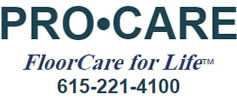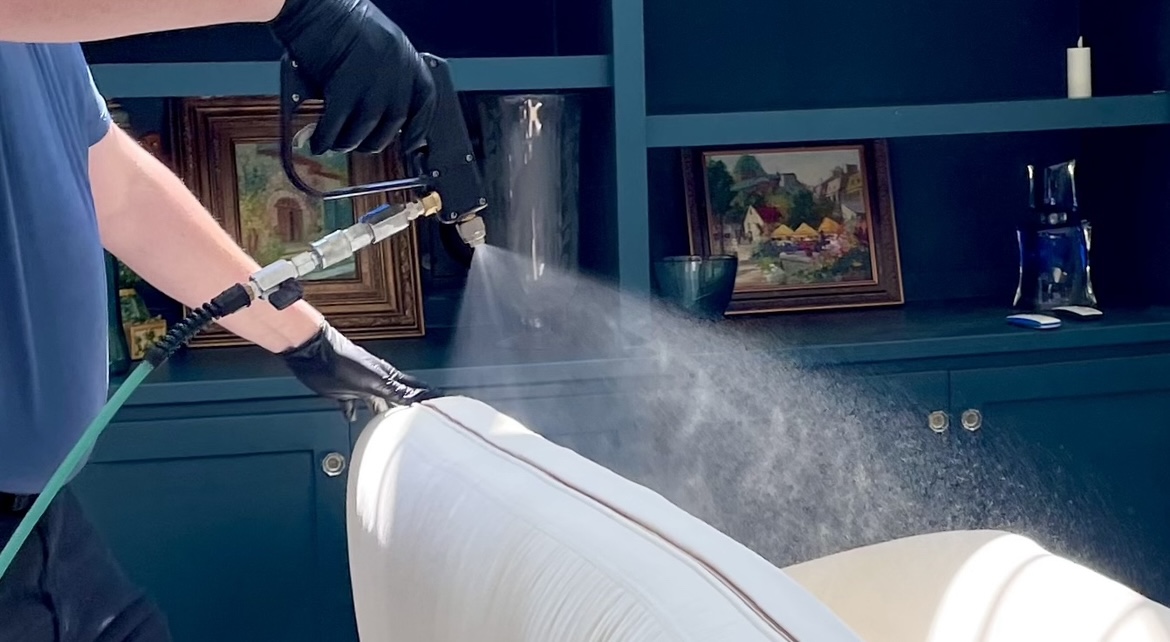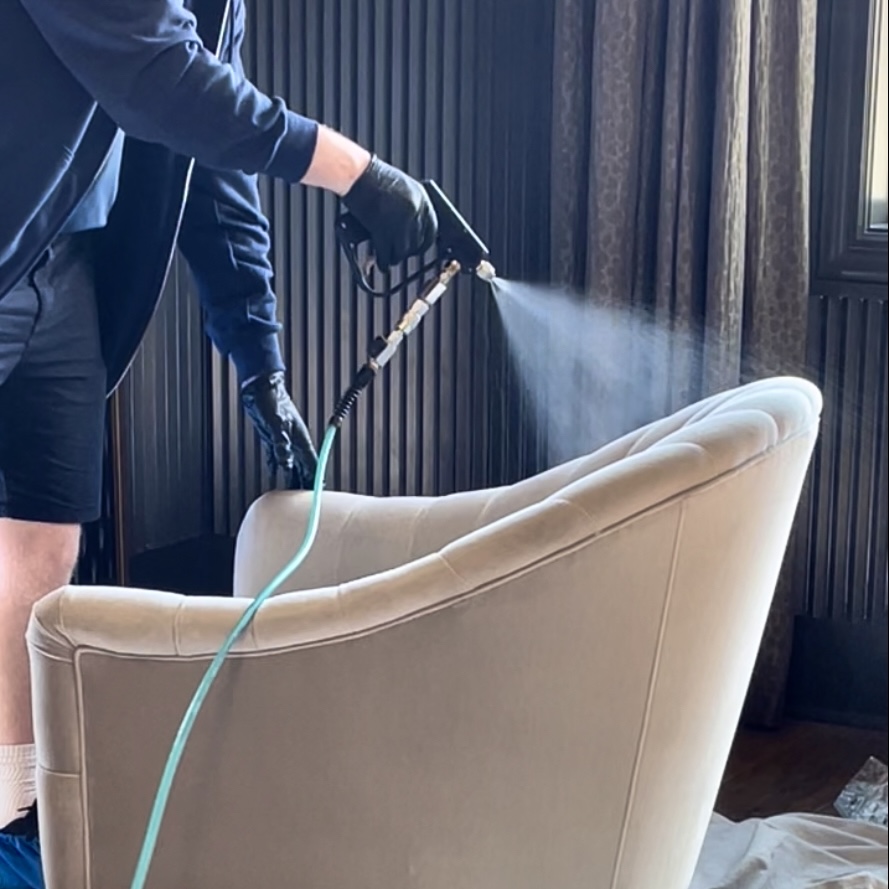When it comes to Fabric Protector Sprays, homeowners usually have a lot of questions. Luckily, we have some answers! Let us share a few basic truths about fabric protection. Then you can decide the best way to protect your own household from those everyday spots and spills.
First, a little clarification.
The field of fabric protection can be a little complicated and lots of fabrics are manufactured to be stain-resistant. Let’s start with a quick look at the three types of protection out there. 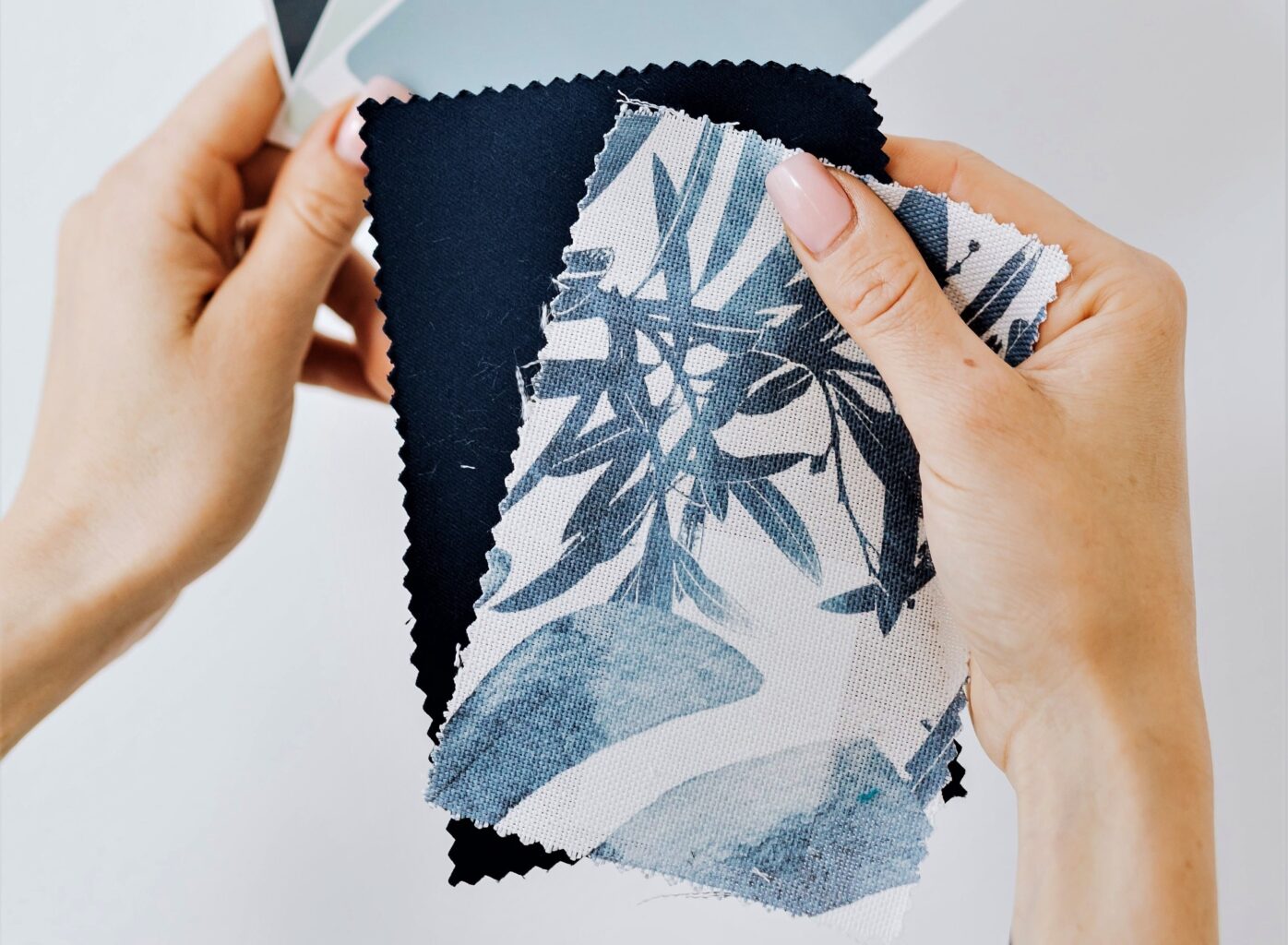
One version of stain resistance comes from the synthetic make-up of the fiber itself. The Sunbrella company, for example, manufactures their textiles from 100% acrylic fibers. They guarantee their product for the lifetime of the furnishing. Acrylic fibers are inherently stain-blocking. However, even these surfaces benefit from regular cleaning and care. The thing to remember is that acrylic is a fiber type, not a protective layer. Fabrics like those manufactured by Sunbrella are hardy enough for indoor and outdoor applications.
A second version of protection embeds itself in the fibers of a textile. Crypton fabrics use this type of integrated moisture barrier. Crypton provides a 5-year warranty for the performance of their fabrics, with some exceptions, including the failure to have the upholstery regularly cleaned. This is a fiber barrier, not a surface application. Five years down the road, cleaning and protection might be called for. Crypton is an example of an indoor “performance fabric.”
When we refer to fabric protector spray, it is a third category of protection that we mean. Sprayed protection is applied after-market. There are a lot of versions out there, including to-the-trade products that a professional company can apply to your upholstery, for a fee. There are also retail protectors that you can purchase and apply yourself. These options differ in many ways but let’s start with safety. On to the top ten FAQs!
1. Are fabric protector spray products safe?
Historical Perspective
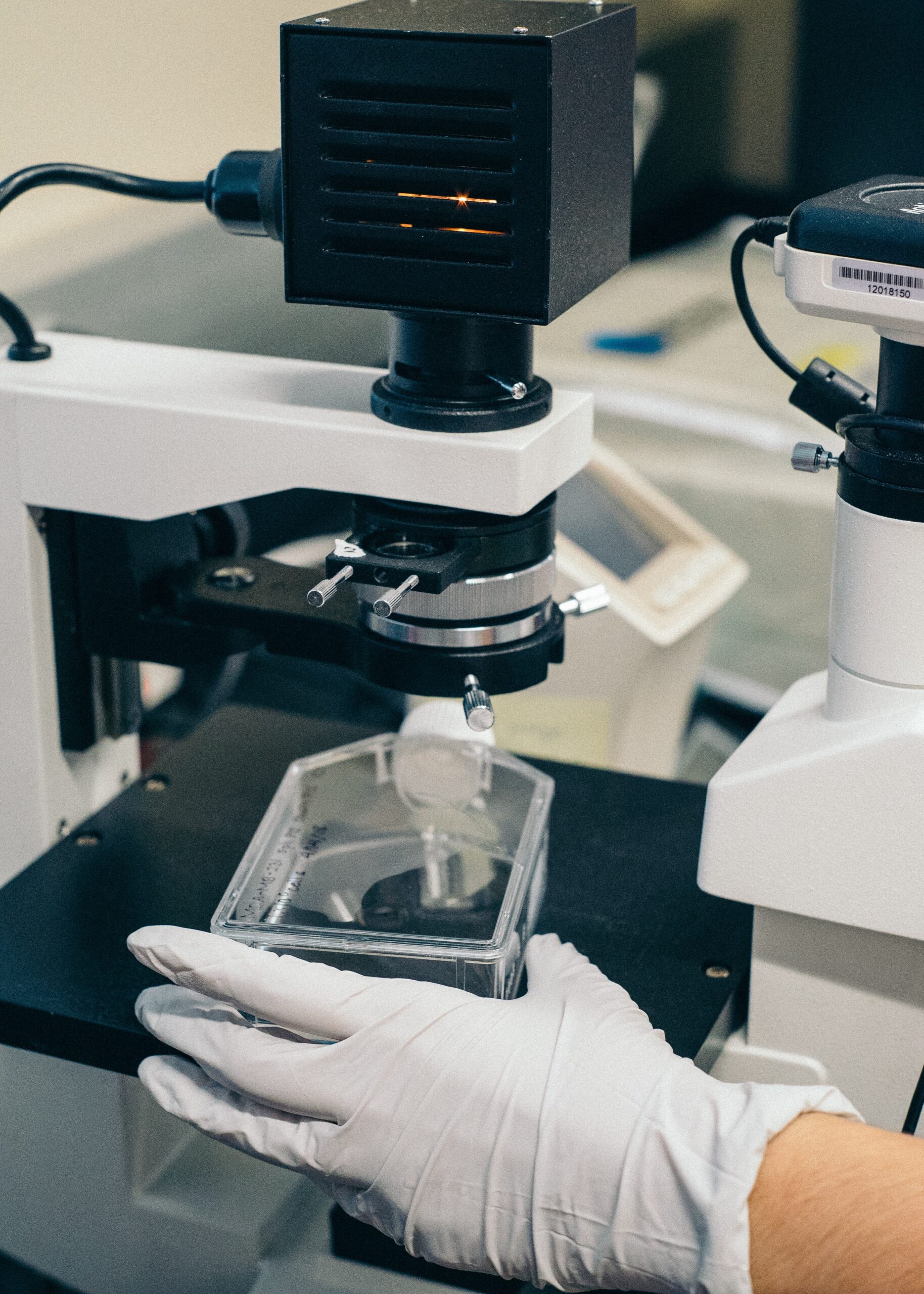 Protection is more safe now than ever. However, some protectants are safer than others.
Protection is more safe now than ever. However, some protectants are safer than others.
Case in point, Scotchguard, which first hit the shelves in 1956. At the time it was hailed as the best protectant formula available. But studies began to show that chemicals called PFOSAs, found in the Scotchguard profile, were toxic in the human body and showed no signs of bio-degrading over time. The EPA stepped in in 1999 and Scotchguard tweaked its formula in 2003. However, there are still questions about this newest recipe that Scotchguard has not fully answered.
Dupont’s “Teflon,” an early rival to Scotchguard used on cookware as well as textiles, has been similarly flagged. Dupont hid evidence from 1981 on about the chemical profile of its product. It was not until 2005 that the EPA was able to sue Dupont for the long-time, unclaimed dangers of its formula.
Given these headline makers, it is no surprise homeowners have concerns. Basically, over the years, there has been a lot of press that has called the safety of protectant products into question, and rightly so.
Contemporary Findings
The good news is that oversight is finally being brought to bear. Some products have even been banned by big box stores because of their use of PFAS and PFOS. So the market is more attuned to safety in the protection industry than ever. The fabric protector spray market has expanded in the past decade. The best protectants are both family and earth friendly. Also, they contain no fluorocarbons or silicates.
At Pro-Care, we’re big fans of a product called Fiber ProTector. This protectant has been shown to be non-toxic, hypo-allergenic and bacteriostatic and has been around since 1994. Manufactured in two formulations, the water-based line of protection from this company recently received the WoolSafe EnviroSeal certification. This is the only fabric protector ever to receive such a certification. Read published test results to learn more about the safety of Fiber Protector.
2. How long does fabric protection last? 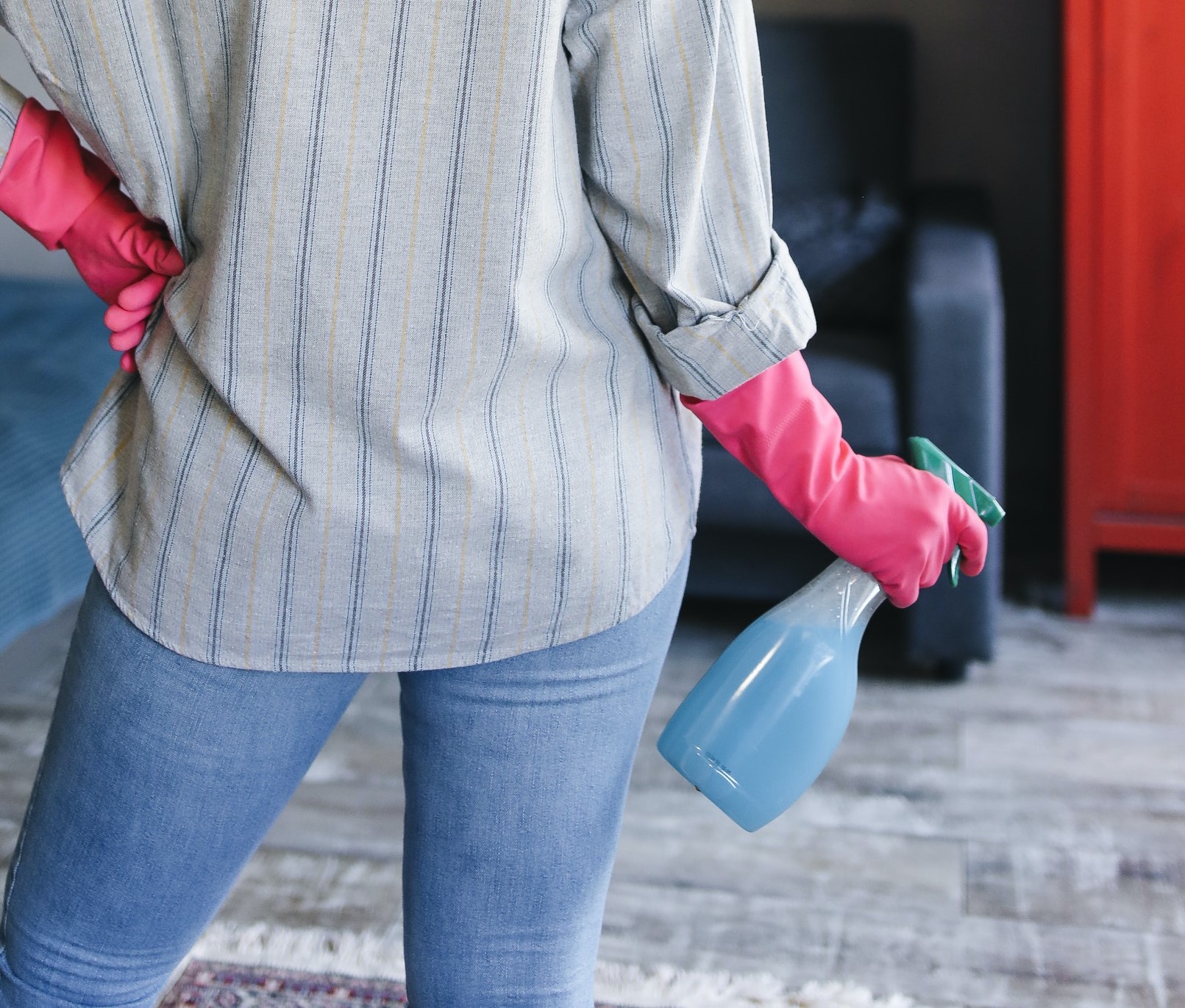
So mill-applied protectors can be expected to last for the length of their warranties, usually 3-5 years. Unlike the protection in the warranty world, the effectiveness of after-market fabric protector sprays differs from brand to brand, and application to application. Some treatments can require reapplication as often as every six months. Here’s why.
Retail products differ from commercial grade ones. The ‘over the counter’ options are usually sold in a hand-pump bottle. No matter how itchy your trigger finger is, it’s hard to get the sort of saturation and coverage you need from a bottled product. Even after a comprehensive application, the strength of the retailed solution can be undercut by the safety requirements for end-use.
Commercial protection sprays are more effective. The pros use a spray wand to control the amount of product used. They overlap passes of the protective solution to achieve more thorough stain resistance. If a homeowner responds quickly to accidents and if the treated upholstery is exposed to modest use, trade protectants can last up to two years.
Sometimes, before the two years is up, upholstery is ready for a deep, professional cleaning. That is a great time to schedule the re-application of protection too. Of course, in the most heavily used settings, you may need to have that sofa or sectional cleaned every year. The upshot is, professionally applied fabric protector spray should last til the next professional cleaning or every two years, whichever comes first.
3. Does fabric protection spray really work?
Yes, protection sprays help keep spots and spills from soaking in and staining upholstery – as long as the user responds to accidents immediately. A spill left for hours on a sofa or rug is likely to penetrate any topical treatment. That said, a commercial spray will perform better than a retail product.
The heavier the stress on your furnishings, the faster a protective coating wears away. Deep cleaning or heavy use will require regular re-application. The good news is that, in addition to its efficacy with spots and spills, protection guarantees better removal of even the everyday grunge that builds up on your furniture and floors. Granted, no product will make your upholstery completely stain proof. However, one of the many benefits of a quality fabric protector spray is its ability to give the professional cleaner a fighting chance to restore the textile. That can be true for everything from a specific accident to a year of moderate soiling.
4. What kinds of fabric can be protected?
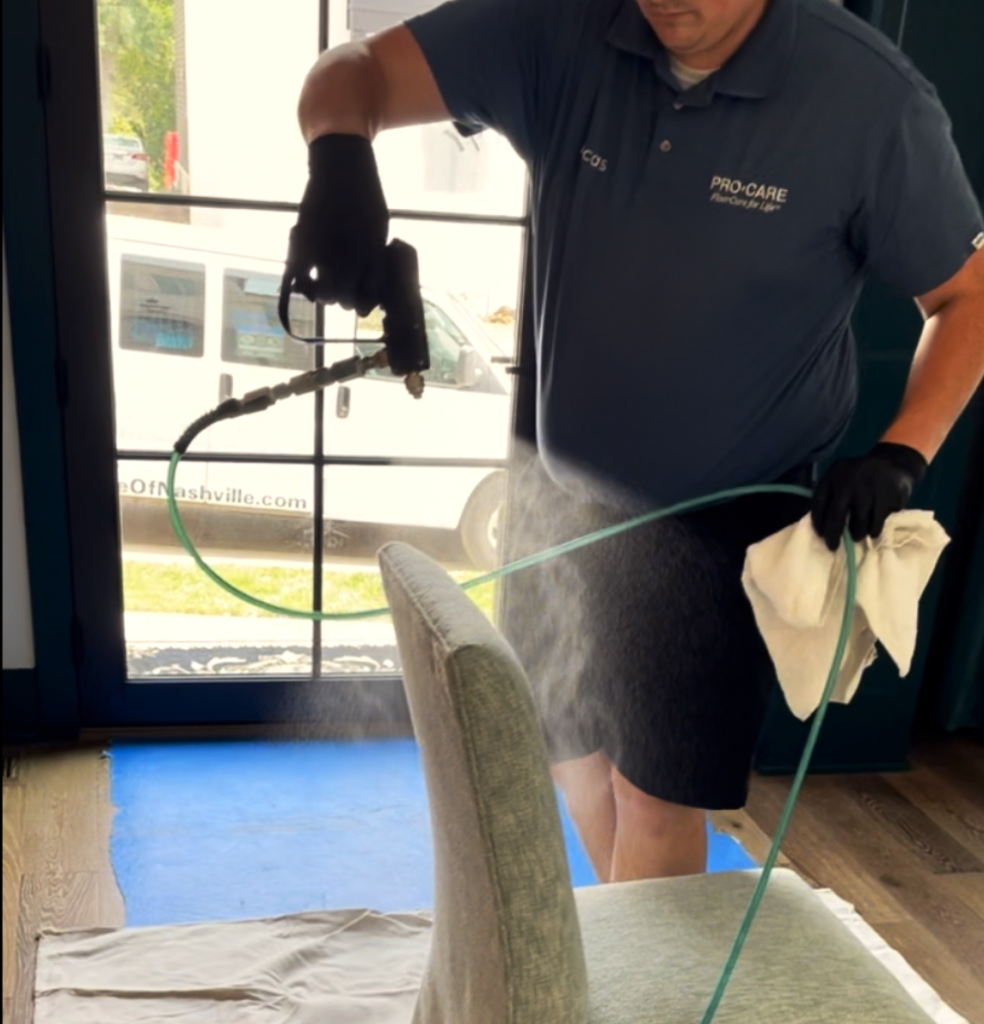 This is a great question for your local protection company. Professionals say they are confident applying protectants to just about every upholstery fabric out there. The key is to vet the treatment that your pros use. If your furnishing is an antique, upholstered in a delicate silk, you may want to reconsider protection altogether. And be mindful that some products may have some limitations. For example, a protection with sun fade resistance may not also feature a fire retardant.
This is a great question for your local protection company. Professionals say they are confident applying protectants to just about every upholstery fabric out there. The key is to vet the treatment that your pros use. If your furnishing is an antique, upholstered in a delicate silk, you may want to reconsider protection altogether. And be mindful that some products may have some limitations. For example, a protection with sun fade resistance may not also feature a fire retardant.
A fabric protector spray that comes in both a water-based and a non-water-based version will have the most versatility. And in some cases, the treatment of specific textiles is highly advisable. The truth is, manufacturers of products like viscose, jute and sisal should always require an after-market protective treatment. Believe it or not, even water can damage these types of surfaces!
The great thing about planning for protection is that, when you go shopping for new upholstery, you can choose whatever color and fiber type you prefer. Like light colors? Go ahead and purchase. Active household? No problem. Let the pros help you match the lifestyle issues that concern you most with an effective option.
Pro Tip: Just because a brand name has been out there awhile, doesn’t mean that it is safe or effective. It turned out that the ingredients that once made ‘Scotchguard’ the go-to for fabric protection were unhealthy for people. However, the name ‘scotchguard’ has huge brand recognition, so much so that it has become a verb. Clients often ask if a business can ‘scotchguard’ their sofa. What they really mean is that they want their sofa treated with a protective spray.
5. Will Fabric Protection change the feel or color of my fabric?
If you are choosing a fluoropolymer treatment based on nanotech particles, you can be confident that this protection will not impact the look or the texture of your upholstery. Avoid any fluorochemical products. These environmentally unfriendly substances, also referred to as PFOAs and PFOSs, have appeared in many of the most popular protectors. Plan to stay away from silicone-based treatments too. These can cause textiles to yellow and attract dirt over time.
6. After application, how much drying time will a typical protector spray require?
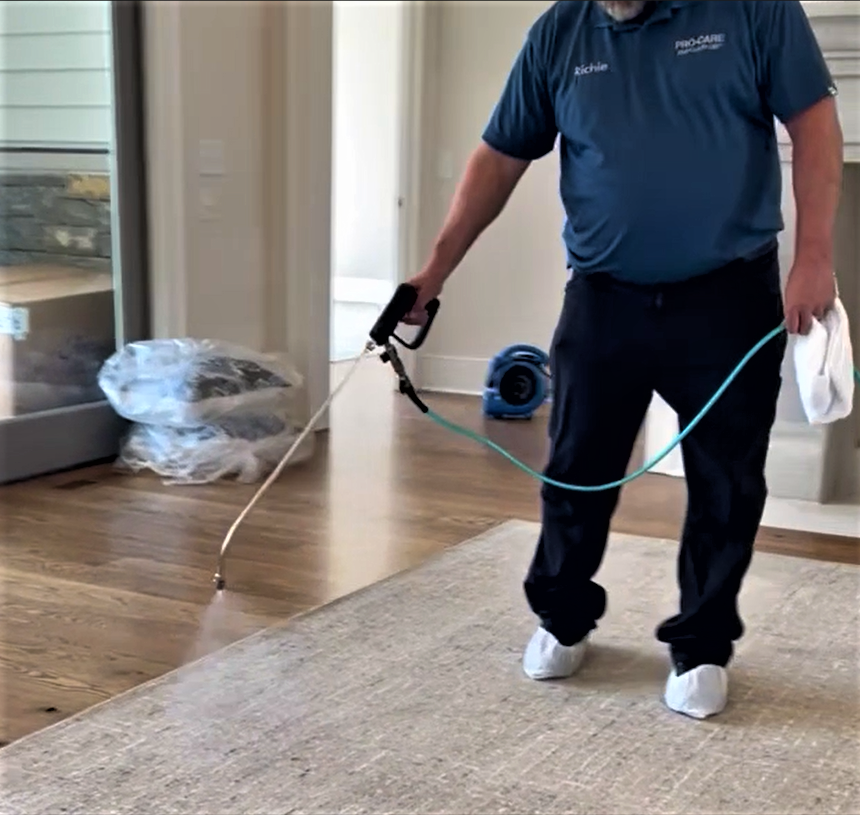 Let’s say you’ve decided to schedule that professional protection appointment. The next thing is to plan your household activity around that service. Start by keeping family and pets away from the area during and immediately after the appointment. A piece treated by fabric protector spray may take as little as two or as much as six hours to dry. Remember, the climate can influence the dry-time required because humidity slows the drying process.
Let’s say you’ve decided to schedule that professional protection appointment. The next thing is to plan your household activity around that service. Start by keeping family and pets away from the area during and immediately after the appointment. A piece treated by fabric protector spray may take as little as two or as much as six hours to dry. Remember, the climate can influence the dry-time required because humidity slows the drying process.
Professionals usually advise clients to plan 4-6 hours for their furnishing to dry to the touch. In the ideal scenario, though, people will set aside 24 hours of curing time before exposing their item to regular use. That’s because protective polymers encapsulate the fibers of home textiles and that process takes time. So, while the best stainguards are harmless to humans, pets, and the environment, it is still advisable to keep everyone and everything off the treated items until fully cured.
Take care not to spill anything on your newly protected furnishing, for the first 24 hours. If the protected item is a rug, wait until that rug is dry before moving anything back on top of it. If you ask the pros to lift an item back onto your rug before they leave the site, make sure they put plastic tabs or blocks under that item to protect the surface of the rug while it is curing.
7. Are furniture and upholstery protectors waterproof?
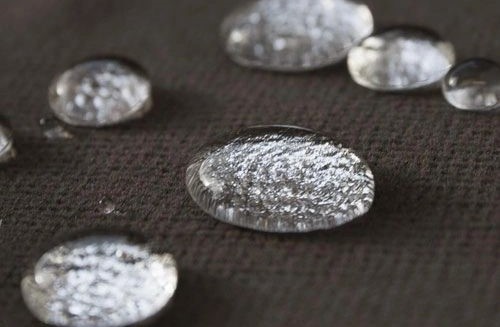 Probably the only truly waterproof furniture guard out there is Grandma’s plastic sofa cover. Most protection is more likely to be water-resistant than waterproof. An effective protectant will encapsulate fabric fibers while still allowing them to breathe. It will help spills to bead up on the surface of the textile and and buy the homeowner time to blot up the accident.
Probably the only truly waterproof furniture guard out there is Grandma’s plastic sofa cover. Most protection is more likely to be water-resistant than waterproof. An effective protectant will encapsulate fabric fibers while still allowing them to breathe. It will help spills to bead up on the surface of the textile and and buy the homeowner time to blot up the accident.
The key is to act quickly. Left untended, spills and other liquids will penetrate even outdoor fabric. The best protection will allow for airflow while still leaving the surface of the fibers “hydrophobic and oleophobic.” That means your treated upholstery or rug should be able to repel water-based stainers like black coffee and oil-based spills like that buttery forkful of mac and cheese.
Make sure to call your local pros before employing any aggressive cleaning strategies on protected furnishings. You always want to blot an accident, never rub or scrub. Friction can grind the spot or spill deep into the surface of the rug or upholstery, past any protective layer. Remember too, some of the advice on the internet is not professionally vetted. For more information about the best response to accidents, check with a reputable company. When it comes to cleaning various types of spills, it’s best to trust the pros!
8. Can I use furniture and upholstery protectors on leather or suede furniture?
The chemical profile of a protectant will determine its effectiveness on natural fibers. Some topical treatments can actually damage hide-based surfaces so it is always advisable to ask the pros if their product is leather and suede safe. If you are going it alone, and we’re not advising that, be sure to read the back of the bottle. When there is no mention of leather and suede at all, assume the manufacturer does not guarantee the safety of those surfaces. Look for an outright statement that the product will not damage animal hide.
9. Are there any guarantees or warrantees for fabric protection?
 Warranties
Warranties
So here’s something important to know, when it comes to your furniture’s warranty. When you purchase upholstery, its warranty generally covers any manufacturing defects that may show up after delivery. It also protects against premature failure of structural components, like breakage of the wood frame or pancaking of the foam in the cushions.
But, in all but the most extreme scenarios, that new-furniture-warranty does not cover the performance of the fabric, which is the part of your sofa most likely to suffer damage from everyday use. The catch-22 is that most manufacturers will void your warranty if you choose to put after-market protection on that sofa or chair. Don’t believe us? Read over that warranty again (or use this sample).
You have to make the decision that feels most responsive to your life and your needs. Some clients wait til their structural coverage expires. After that, they schedule a deep cleaning and a professional protective spray with confidence. Other families take the chance that their new furniture will remain structurally sound and go ahead with protection up front, even if that results in a loss of warranty coverage from their upholstery manufacturer.
Guarantees
As far as guarantees go, it is tricky to get a guarantee on stainguard products themselves. The company that produces the fabric protector spray can always claim that it was inappropriately or poorly applied. What you want to look for is the guarantee of the professionals who perform your service. Before you schedule, ask the service company about their protective solution and their guarantees.
Some upholstery specialists will give you a service agreement to come back and clean stains on a case-by-case basis. Other businesses have a general satisfaction guarantee to insure the care of their clients. Read that company’s reviews across several sites. You’ll be able to tell whether the business is trustworthy and will stand behind their work.
10. Can I just save the money and protect my sofa myself?
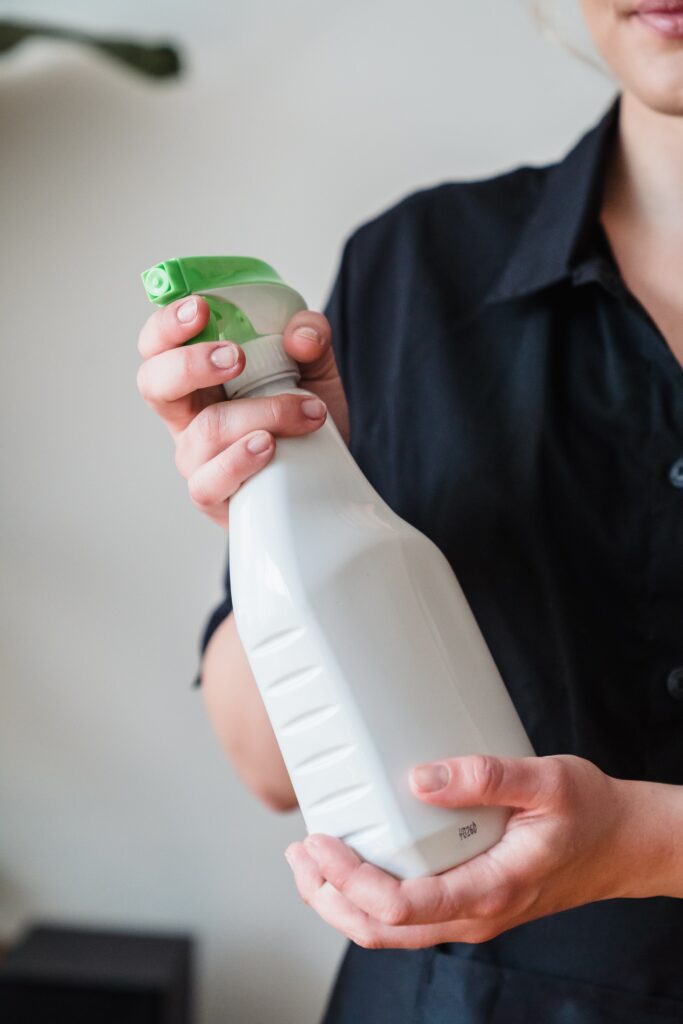 In some situations, the DIY option can rival the results of a professional service. In the arena of DIY fabric protection, that is not usually the case.
In some situations, the DIY option can rival the results of a professional service. In the arena of DIY fabric protection, that is not usually the case.
To begin with, upholstery care professionals have specialized equipment to insure the best flow and coverage of the protective solution. When you are working with highly-trained technicians, you can feel confident that your furniture gets an even, overlapping coat of protection. Also, a professional company can clean the protected items, down the line, when months or years of use have accumulated some dust and discoloration.
One of the key benefits of having your upholstery and rugs protected is that they will look newer, longer, and will hold up better to wear and tear. The idea is to save you the money you’d otherwise use for constant deep cleanings or even the premature purchase of a replacement sofa or sectional. However, those benefits depend upon the protective layer combining an effective product that is thoroughly and evenly applied.
Unfortunately, retailed, pump-bottle or aerosol can fabric protector sprays are formulated to be weaker than trade-rated products. What’s more, the bottle itself does not provide the coverage necessary for optimal outcomes. Ultimately, there are few guarantees for product performance if you’ve applied the product yourself.
If you have more questions, ask your local pros!
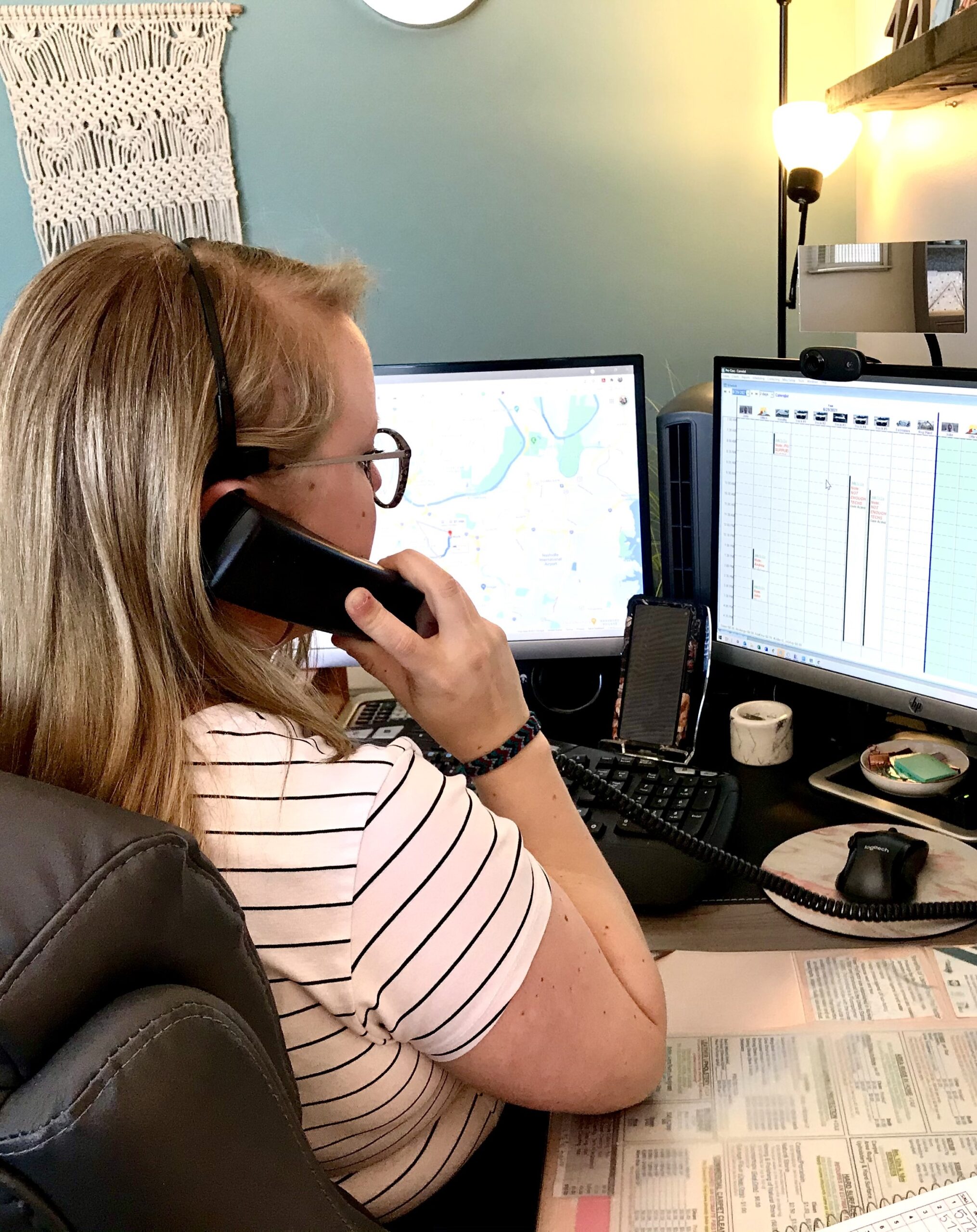 We’ve tried to address the most popular questions about fabric protector spray but we may not have addressed every concern. If you still have questions, please find a trustworthy local company that specializes in textile care.
We’ve tried to address the most popular questions about fabric protector spray but we may not have addressed every concern. If you still have questions, please find a trustworthy local company that specializes in textile care.
If you decide to move forward with the pros, there is great information out there about the best steps for preparing for your fabric protection appointment.
Not sold on on the service? Let folks who have success stories to share talk you through the benefits. You may find that the long-term savings on cleaning and care of your furnishings, the good health impacts on your home’s IAQ and the chance to keep that sofa you love out of the landfill will more than match the expense of professionally applied fabric protection.
For more information about Fiber ProTector®
www.FiberProTectorOfnashville.com
